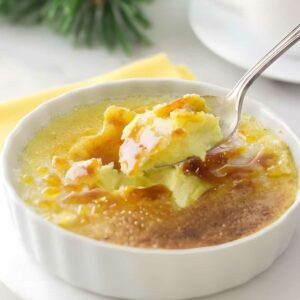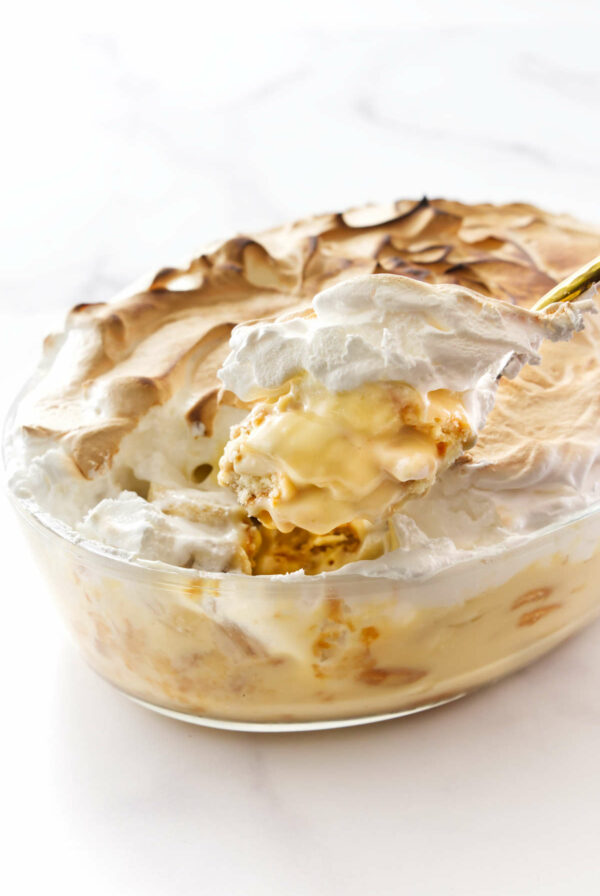This post may contain affiliate links. Please read our disclosure policy. As an Amazon Associate, I earn from qualifying purchases.
Vanilla crème brûlée is the ultimate contrast with a silky custard on the bottom and a crisp sugar shell on top that begs to be cracked. This French vanilla custard sticks to the essentials with rich cream, egg yolks, and real vanilla bean for deep, aromatic flavor. The best part? You can skip the fussy water bath. A gentle, low-temp bake makes it foolproof, and a quick hit from a torch or broiler gives you that signature glassy lid.

Love silky desserts? My Vanilla Pastry Cream is another versatile custard you can use in pastries and layered desserts.
Here’s Why This Creme Brulee Recipe Works
Deep vanilla flavor: Real vanilla bean (or paste) infuses the custard with warm, complex notes that bottled extract just can’t match.
Skip the water bath: A gentle, low-and-slow bake sets the custard evenly, no juggling boiling pans or dealing with extra steps.
Silky-smooth custard: Straining the mixture before baking removes foam and stray egg bits, ensuring a flawless, creamy texture.
Foolproof brûlée topping: Whether you use a torch or the broiler, the sugar melts into a thin, glassy crust that shatters with the first tap of a spoon.

If you love the smooth custard base in this crème brûlée, you’ll enjoy my salted caramel custard too.
Recipe Tips
Split and scrape well: Cut the vanilla bean lengthwise, scrape out every seed, and stir them into warm cream. This loosens the seeds and spreads the flavor evenly.
Whisk gently: Skip the mixer—over-whisking adds foam and air bubbles that ruin a silky custard. A spoon or soft whisk is all you need.
Strain every time: A fine-mesh strainer catches stray egg bits and foam, guaranteeing a smooth, velvety texture.
Pick the right ramekins: Shallow dishes bake faster and give the best custard-to-caramel ratio. Deeper ones work too—just add a few minutes and watch for that signature wobble.
Broil smart: For even caramelization, place ramekins on an inverted baking sheet to get closer to the heat. Pull them as soon as the sugar turns glossy and golden.


Cream Brulee
Crème brûlée feels fancy, but this recipe proves it doesn’t have to be complicated. With a smooth custard base, a golden sugar crust, and no water bath required, it’s an elegant dessert you can actually pull off at home.
Serve it straight from the ramekins with fresh berries or a little whipped cream, and enjoy the crack of that caramelized topping. If you love custard-style desserts, you might also like my goat cheese custard for another make-ahead recipe.
Pin this now to find it later!
Pin It
Vanilla Bean Creme Brulee
If you make this recipe, please leave a star rating and comment.
Equipment
Ingredients
- 1 cup whole milk
- 1 to 2 vanilla beans, or 1-2 teaspoon vanilla bean paste
- ⅔ cup granulated sugar
- 8 egg yolks
- 2 cups heavy cream
- Pinch salt
- ⅓ cup brown sugar
Instructions
- Preheat oven to 224°F. Place 6 ramekins, (6 ounces each) on a baking sheet, set aside
- Add the whole milk to a saucepan set over medium heat and keep it warm.
- Using a paring knife, split the vanilla bean lengthwise from tip to end. Open it flat and scrape out the seeds from both sides. Stir the seeds into 1 tablespoon of warm water to loosen them, then whisk into the milk. Heat the milk just until it’s almost boiling, remove from the heat, and add the scraped bean pod. Let it steep while you stir in the sugar until dissolved. Set aside to cool to lukewarm.
- In a large bowl, whisk the egg yolks until pale. While continuing to whisk gently, slowly pour the cream into the egg mixture.
- Remove the vanilla bean from the cooled milk-sugar mixture and pour into the egg-cream mixture. Add the salt and combine well.
- Strain the mixture through a fine-mesh strainer to remove any egg bits and foam. Transfer the mixture to a spouted pitcher and fill each ramekin.
- Transfer the baking sheet with the ramekins to the middle rack of the oven and bake for 55-60 minutes.
- Remove from the oven and place on a wire cooling rack until they come to room temperature. Transfer to the refrigerator for at least 4 hours or overnight.
When Ready To Serve:
- Within 15-20 minutes of serving, set the oven to broil and place a rack to it’s highest level. Take the ramekins from the refrigerator and sprinkle a tablespoon of sugar on each one. Set the ramekins on a baking sheet and place under the broiler for 2 minutes. Remove as soon as the sugar turns liquid and begins to caramelize.
- Alternatively, use a kitchen brulee torch to melt the sugar and get a nice crust.
- Refrigerate for 10-15 minutes to cool and serve within 1 hour.
Notes
Nutrition
Nutrition information is automatically calculated, so should only be used as an approximation.
 Like this recipe? Rate & comment below!
Like this recipe? Rate & comment below!















I believe the nutrition/calorie count is underestimated,ie, 2 c of heavy cream is about 1644 cal, 8 egg yolks is about 440-480. Also loaded with saturated fat and sugar. So of course it is delicious!
A.Flickinger, RN, MSN
Ah-ha, I believe you are right, Anne! I re-checked the calculations and it is 493 for calories and 36 for fat. I made the correction in the recipe card. Thanks so much for a good catch!